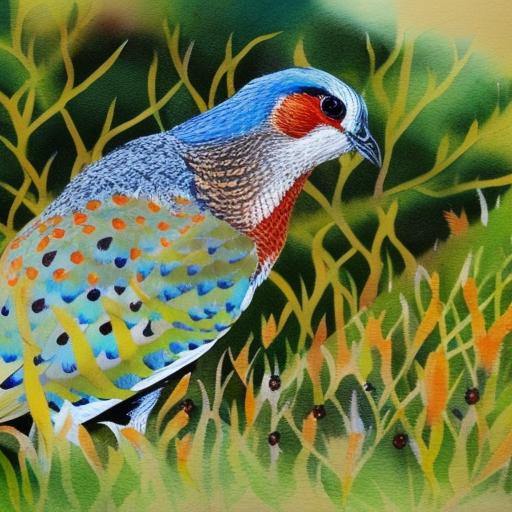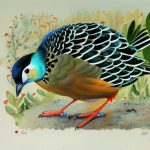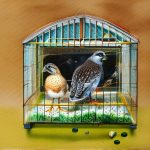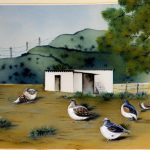The King Quail, also known as the Button Quail, is a small ground-dwelling bird native to Australia and New Guinea. They are popular among bird enthusiasts for their small size, colorful plumage, and interesting behaviors. King Quails are known for their distinctive call, which sounds like a series of whistles and chirps. They are social birds that thrive in small flocks and are relatively easy to care for, making them a popular choice for aviculturists.
King Quails are sexually dimorphic, meaning that males and females have different physical characteristics. Males are typically more brightly colored and have a distinctive black throat patch, while females are duller in color and lack the black throat patch. They are also known for their unique breeding behavior, which involves the male performing a courtship display to attract a mate. Understanding the natural behaviors and characteristics of King Quails is essential for successful breeding, as it allows breeders to create an environment that mimics their natural habitat and behaviors.
In the wild, King Quails are ground-dwelling birds that prefer open grasslands and scrubby areas. They are known for their secretive nature and tend to stay hidden in dense vegetation to avoid predators. Understanding their natural habitat and behaviors is crucial for creating a suitable breeding environment that meets their specific needs. By understanding the natural behaviors and characteristics of King Quails, breeders can provide the best possible care and environment for successful breeding.
Key Takeaways
- King quails are small, ground-dwelling birds native to Australia and are popular for their colorful plumage and distinctive calls.
- When selecting a breeding box for king quails, it’s important to choose a box that is spacious, secure, and easy to clean.
- Setting up the breeding box involves adding a layer of substrate, such as sand or peat moss, and providing a shallow dish of water for bathing.
- Providing the right environment for breeding includes maintaining a stable temperature, humidity, and lighting, as well as offering a balanced diet rich in protein and calcium.
- Monitoring the breeding process involves observing the quails for signs of mating, egg-laying, and incubation, and making adjustments to the environment as needed.
- Caring for the chicks involves providing a warm, safe, and clean environment, as well as offering a diet of small insects, seeds, and fresh greens.
- Tips for successful king quail breeding include pairing compatible birds, providing ample space and hiding spots, and seeking advice from experienced breeders.
Selecting the Right Breeding Box
Selecting the right breeding box is crucial for successful King Quail breeding. The breeding box should be spacious enough to accommodate a pair of quails comfortably, with enough room for nesting materials and space for the birds to move around. It should also be secure and well-ventilated to provide a safe and comfortable environment for the birds. Additionally, the breeding box should be easy to clean and maintain to ensure the health and well-being of the birds.
When selecting a breeding box for King Quails, it’s important to consider the material and design of the box. Wooden or plastic breeding boxes are popular choices, as they provide a natural and comfortable environment for the birds. The box should have a secure lid or cover to prevent the birds from escaping and to protect them from predators. It should also have a removable bottom or tray for easy cleaning and maintenance.
The size of the breeding box is also an important consideration. The box should be large enough to accommodate a pair of quails comfortably, with enough room for nesting materials and space for the birds to move around. A spacious breeding box allows the birds to exhibit natural behaviors such as courtship displays and nesting activities. It also provides a comfortable environment for the birds to raise their chicks. By selecting the right breeding box, breeders can create a suitable environment for successful King Quail breeding.
Setting Up the Breeding Box
Setting up the breeding box is an important step in preparing for King Quail breeding. The breeding box should be filled with suitable nesting materials such as straw, hay, or shredded paper to provide a comfortable and secure environment for the birds to lay their eggs. The nesting materials should be clean and free from any contaminants or toxins that could harm the birds or their chicks. Additionally, the breeding box should be placed in a quiet and secluded area to provide the birds with privacy and reduce stress during the breeding process.
When setting up the breeding box, it’s important to provide suitable perches or platforms for the birds to roost and rest. Perches should be placed at different heights to allow the birds to move around and exhibit natural behaviors such as courtship displays and nesting activities. The perches should be made from natural materials such as wood or bamboo to provide a comfortable and secure surface for the birds to rest on.
The breeding box should also be equipped with suitable food and water dishes to provide the birds with essential nutrients and hydration during the breeding process. The dishes should be placed in a secure location to prevent spills and contamination of the nesting materials. By setting up the breeding box with suitable nesting materials, perches, and food and water dishes, breeders can create a comfortable and secure environment for successful King Quail breeding.
Providing the Right Environment for Breeding
Providing the right environment for breeding is essential for successful King Quail breeding. The breeding environment should mimic the natural habitat of the birds, with suitable nesting materials, perches, and food and water dishes to meet their specific needs. Additionally, the breeding environment should be quiet, secluded, and free from any disturbances or stressors that could disrupt the breeding process.
The temperature and humidity of the breeding environment are also important considerations for successful King Quail breeding. The breeding environment should be kept at a consistent temperature of around 70-80 degrees Fahrenheit to provide a comfortable and stable environment for the birds. Additionally, the humidity level should be maintained at around 50-60% to prevent dehydration and ensure the health and well-being of the birds.
Lighting is another important factor in creating the right environment for breeding. The breeding environment should be equipped with suitable lighting to provide a natural day-night cycle for the birds. Natural sunlight or full-spectrum lighting can help regulate the birds’ reproductive cycles and encourage breeding behavior. By providing the right environment with suitable temperature, humidity, and lighting, breeders can create an ideal environment for successful King Quail breeding.
Monitoring the Breeding Process
Monitoring the breeding process is essential for successful King Quail breeding. Breeders should observe the behavior of the birds regularly to ensure that they are exhibiting natural courtship displays, nesting activities, and mating behaviors. Additionally, breeders should monitor the condition of the nesting materials, eggs, and chicks to ensure that they are healthy and developing properly.
During the breeding process, it’s important to observe the behavior of the birds closely to ensure that they are exhibiting natural courtship displays and mating behaviors. Males may perform elaborate courtship displays such as puffing up their feathers, bobbing their heads, and making vocalizations to attract a mate. Females may respond by crouching down and allowing the male to mount them for mating. By monitoring these behaviors, breeders can ensure that the birds are healthy and ready for breeding.
Breeders should also monitor the condition of the nesting materials, eggs, and chicks regularly to ensure that they are healthy and developing properly. The nesting materials should be clean and free from any contaminants or toxins that could harm the eggs or chicks. Additionally, breeders should check the eggs regularly for signs of fertility such as candling or gently rotating them to observe any movement or development inside. By monitoring the condition of the nesting materials, eggs, and chicks, breeders can ensure that they are healthy and developing properly.
Caring for the Chicks

Caring for the chicks is an important aspect of successful King Quail breeding. Once the eggs hatch, breeders should provide suitable food and water dishes for the chicks to ensure that they receive essential nutrients and hydration for healthy growth and development. Additionally, breeders should provide a warm and secure environment for the chicks to protect them from predators and ensure their safety.
When caring for the chicks, it’s important to provide suitable food such as commercial game bird starter feed or finely ground seeds to meet their specific nutritional needs. The food should be placed in shallow dishes to make it easily accessible for the chicks. Additionally, breeders should provide clean water in shallow dishes to ensure that the chicks stay hydrated during their early stages of development.
The chicks should be kept in a warm and secure brooder box or enclosure to protect them from predators and ensure their safety. The brooder box should be equipped with suitable heating sources such as heat lamps or heating pads to maintain a consistent temperature of around 95-100 degrees Fahrenheit for the first week of their lives. As they grow older, breeders can gradually reduce the temperature by 5 degrees each week until they reach around 70 degrees Fahrenheit at 6 weeks of age. By providing suitable food, water, and a warm and secure environment, breeders can ensure that the chicks receive proper care for healthy growth and development.
Tips for Successful King Quail Breeding
Successful King Quail breeding requires careful planning, preparation, and attention to detail. Here are some tips for successful King Quail breeding:
1. Provide a suitable breeding environment: Create a quiet, secluded environment with suitable nesting materials, perches, food, water dishes, temperature, humidity, and lighting to mimic their natural habitat.
2. Monitor behavior regularly: Observe courtship displays, mating behaviors, condition of nesting materials, eggs, and chicks regularly to ensure that they are healthy and developing properly.
3. Provide proper care for chicks: Provide suitable food, water dishes, warm brooder box or enclosure to protect them from predators and ensure their safety.
4. Seek veterinary care if needed: If you notice any signs of illness or distress in your quails, seek veterinary care immediately to ensure their health and well-being.
5. Be patient: Breeding quails can take time and patience. Be patient with your birds and allow them time to exhibit natural behaviors and complete their breeding cycle.
By following these tips and providing proper care and attention to your King Quails, you can increase your chances of successful breeding and enjoy watching your quails thrive in their new environment.
If you’re interested in creating the perfect environment for your king quail, you may also want to check out Poultry Wizard’s article on what vegetables do quails eat. Understanding the dietary needs of your quail is essential for their health and well-being. In addition to providing a suitable breeding box, ensuring that they have access to a balanced diet will contribute to their overall happiness and productivity.
FAQs
What is a king quail breeding box?
A king quail breeding box is a specially designed enclosure or box used for breeding and housing king quails. It provides a safe and secure environment for the quails to breed and lay eggs.
What are the key features of a king quail breeding box?
A king quail breeding box typically includes features such as a nesting area, perches, and a secure door or lid. The nesting area is essential for the quails to lay their eggs, while perches provide them with a place to rest and roost.
How should a king quail breeding box be set up?
The breeding box should be set up with a substrate such as sand or peat moss for the quails to lay their eggs in. It should also include a shallow dish of water for drinking and bathing, as well as a source of heat such as a heat lamp to maintain the appropriate temperature for breeding.
What are the benefits of using a king quail breeding box?
Using a breeding box provides a controlled environment for breeding and nesting, which can increase the likelihood of successful breeding and hatching of eggs. It also helps to protect the quails from predators and other potential dangers.
Are there any specific considerations for breeding king quails in a breeding box?
It is important to monitor the breeding box regularly to ensure that the quails have access to food, water, and a suitable environment for breeding. Additionally, proper hygiene and cleanliness of the breeding box are essential to prevent the spread of disease and ensure the health of the quails.
Meet Walter, the feathered-friend fanatic of Florida! Nestled in the sunshine state, Walter struts through life with his feathered companions, clucking his way to happiness. With a coop that’s fancier than a five-star hotel, he’s the Don Juan of the chicken world. When he’s not teaching his hens to do the cha-cha, you’ll find him in a heated debate with his prized rooster, Sir Clucks-a-Lot. Walter’s poultry passion is no yolk; he’s the sunny-side-up guy you never knew you needed in your flock of friends!







